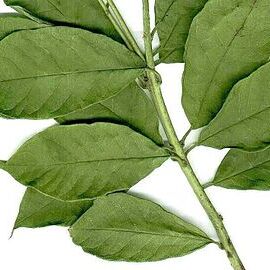Leaves opposite or subopposite or occasionally alternate; lamina 3–10 x 3–4·5 cm. (up to 11·5 x 5·5 cm. in Tanzania), papyraceous, narrowly elliptic to elliptic (to broadly elliptic in Tanzania), rather abruptly acuminate at the apex and cuneate to rounded at the base, usually pubescent on the nerves below but sometimes almost glabrous (except for scales), tufts of hairs in the axils of the nerves beneath absent or rarely conspicuous, lepidote below; lateral nerves 5–8 pairs, rather prominent below, slightly so above; petiole 3–20 mm. long, slender, densely pubescent to almost glabrous, sometimes sparsely lepidote.
A shrub. It has many branches and loses its leaves during the year. It can be 1-12 m tall. It has long trailing branches. These can scramble into trees nearby. The bark is rough and dark brown. The leaves are opposite and narrowly oval. They are 5-10 cm long. They are thin and papery. They are dull green and have hairs on the veins underneath. The tip is long and pointed. The flowers are white to yellow and very small. They have a sweet scent. They can occur singly, in loose spikes or in dense masses. The fruit has 4 wings and is round and 2 cm across. They have small golden scales. The wings are 7-9 mm wide.
Fruit 1·1–1·9 x 1–1·9(2) cm., subcircular in outline or somewhat broader than long, rufous-lepidote otherwise glabrous, apical peg absent or less than 0·5 mm. long, wings c. 7 mm. broad, stipe up to 2 mm. long.
Inflorescences up to c. 10 cm. long, of terminal panicles of spikes often with unbranched spikes in the axils of the upper leaves; rhachis tomentellous to pubescent, ± glabrescent; bracts not seen.
Scales similar to those of C. celastroides but mature leaves with additional smaller scales as little as 50µ in diam. and with a simplified cellular pattern with down to c. 12 marginal cells.
Shrub or small tree usually up to c. 5 m. tall in our area (recorded up to 12 m. in Kenya) or liane; bark silvery-grey, smooth; branchlets puberulous to tomentellous when young, glabrescent.
Small tree or shrub, up to 5 m high. Leaves narrowly elliptic to elliptic, abruptly acuminate at apex and cuneate to rounded at base. Fruit up to 13 mm long. Flowers yellow or white.
Cotyledons 2, 1–1·2 x 1·5–1·8 cm., subcircular to transversely elliptic or subreniform with petioles 2–4 mm. long, borne above soil level.
Flowers sessile, yellow or white, lepidote but otherwise glabrous.
Sepals 1 x l·2 mm., broadly ovate, lepidote otherwise glabrous.
Stamen-filaments 2 mm. long; anthers 0·4 mm. long.
Petals 1–2 mm. long, linear-elliptic, glabrous.
Disk 1·5–2 mm. in diam., pilose.


